Crossing the Atlantic
For Irish emigrants, the journey to America consisted of three phases, each bringing its own difficulties. First of all there was the choice of a port of departure, initially Irish and later English ports, especially Liverpool. Then there was the actual crossing itself, which was often very traumatic, so much so that the phrase "coffin ship" has become part of the lexicon of the history of the Famine. Finally there was the arrival in America where immigrants were faced with the problems of finding shelter and eventually employment and generally adapting to life in a new country.
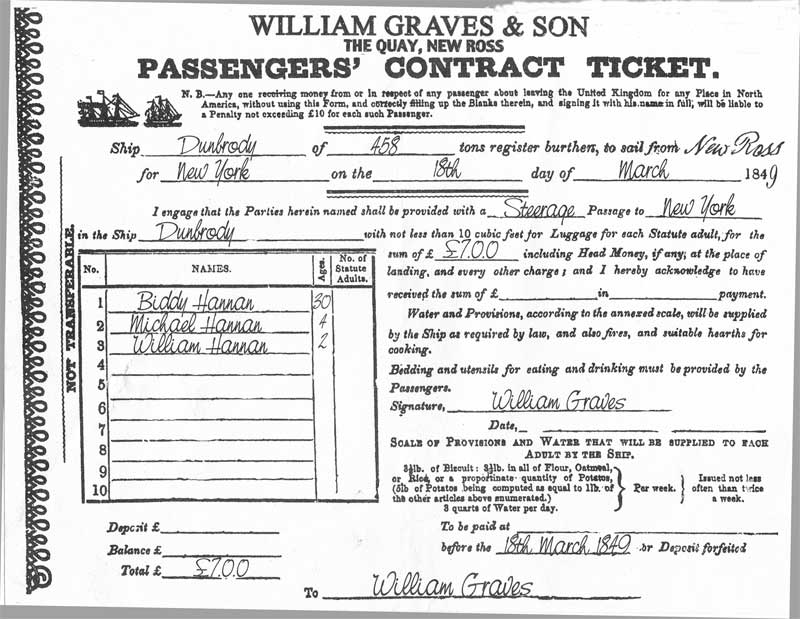
Passengers' Contract Ticket for William Graves & Son, The Quay, New Ross.
Points of Departure
Up to the 1830s the favoured route was to Canada and from there to the United States. The majority of departures were from Irish ports mainly Belfast, Dublin and Derry. After the 1830s, as trade increased between Britain and the US, the cost of the journey from England dropped and increasing numbers of Irish first crossed to Liverpool and from there made their way to New York, Philadelphia and Boston. By the 1840s this had become the established route – cheap and routine. Large numbers also left from ports such as Limerick and Sligo and from small little used ports such as Westport, Killala and Kinsale reflecting desperation as the famine took hold. After 1858 it was possible to travel to America directly from Belfast, Cobh, and Galway.
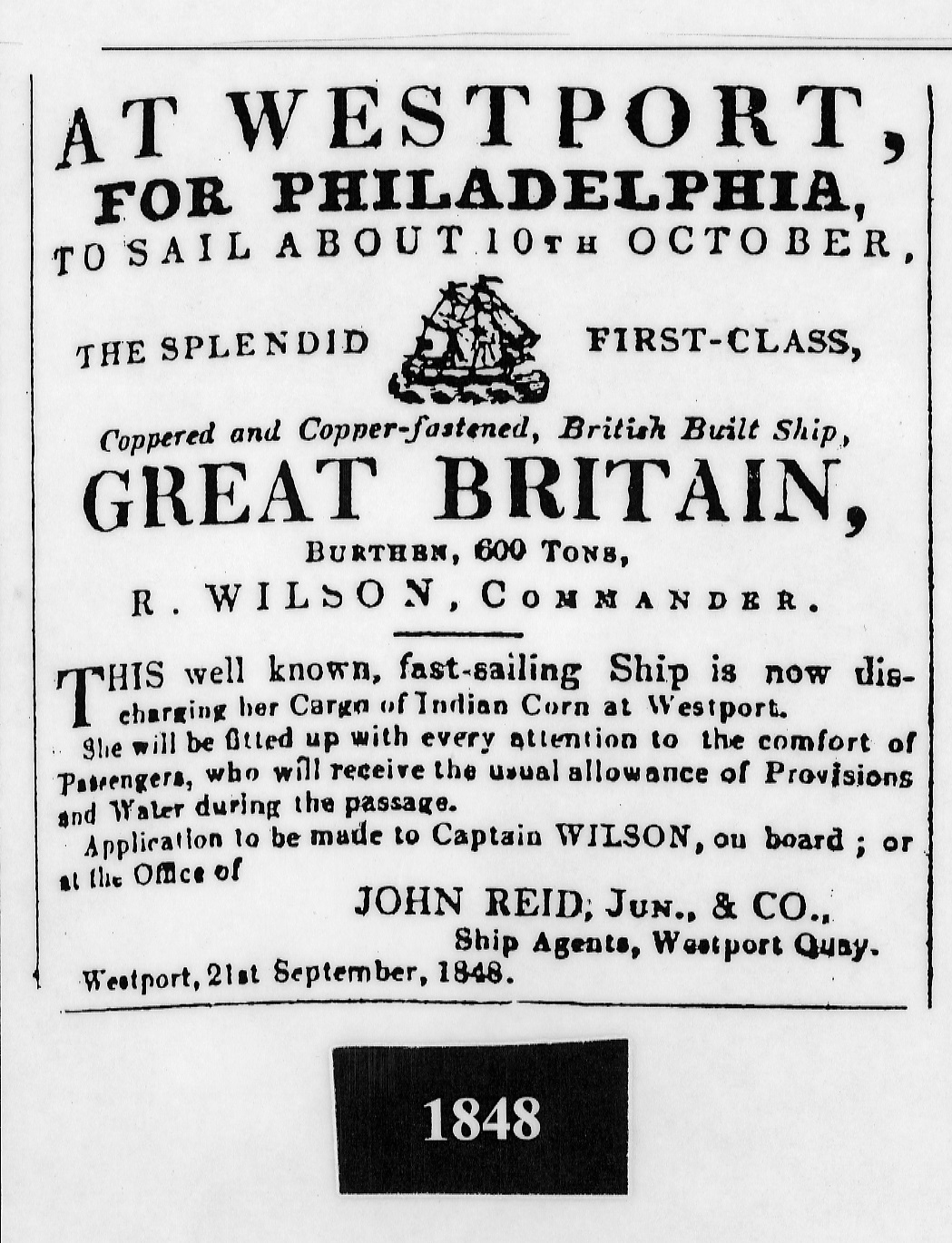
Thousands of Irish emigrants lost touch with their families during the nineteenth century. Personal advertisements in newspapers were used as bulletin boards in an effort to reunite families. Many papers carried a lost friends column through which readers could attempt to trace missing relatives. For example, the Weekly Freeman which circulated among Irish communities abroad carried advertisements from families in Ireland seeking emigrants who had left many years before and disappeared. Many advertisers appear to have been aging parents anxious for news of their emigrant sons and daughters:
"Hayes, Charles; left Ballynew, Castlebar in 180?, last heard of 15 years ago, he was then in Chicago.. Sought for by his mother"
Sometimes newspapers carried advertisements from those who had emigrated, or their children, endeavouring to trace their families who had stayed in Ireland. The Weekly Freeman claimed to have made 75 discoveries in 1899, but this figure represents only a very tiny percentage of the numbers of people being sought. Many thousands must have lost contact never to be found.
Conditions on the crossing from Ireland to Britain were appalling. Deck passengers had lower priority than livestock or baggage and up to 2000 could be crowded on to an open deck in all weathers clinging to each other to avoid being washed overboard. Prices ranged from £4 to £10 per person. The emigrants usually arrived at the dock cold, poor, half-starved and often sick. Here they found board in lodging-houses which were often little more than filthy overcrowded slums. The lodging houses at Liverpool dock in the 1840s were particularly notorious. Hundreds of immigrants would be crammed into dens with men, women and children bedded down together often on a cold floor without blankets. Emigrants could be robbed, cheated and ran the risk of contracting a variety of contagious diseases. They were subject to racketeers and agents for the shipping companies. Among the most common scams was the selling of dollars at exorbitant exchange rates, selling inferior quality clothes and overcharging for boarding. A more sophisticated fraud was to sell American land to emigrants, land which was worthless or which the seller did not even own. It was also known for emigrants to be offered hiding places on ships such as in boxes for a small fee.
Of course newspaper advertisements were also used to try to separate emigrants from their money. The New York Herald of June 1, 1848, ran this ad:
"Emigrants! - The Miseries and troubles of sickness from change of climate can, in a great degree, be saved you if you procure and keep by you the Brandeth Pills to be immediately resorted to should your health become affected. Days, months, nay years of sickness may be thus prevented".
Select the links below to view a photograph of the dreadful conditions on board a ship leaving Liverpool and also a leaflet from the 'Anchor Line' advertising fares etc. for a direct passage from Killala Bay to New York.
The Crossing
In 1851 there were often as many as fifteen ships a day sailing to America from Liverpool. Within eight days in 1851 eleven ships carrying 1568 passengers sailed to America from the port of Cobh in Ireland. In the first half of the century conditions on the trans-atlantic ships were often appalling. The worst death rates occurred during the famine on the notorious “coffin ships” with death rates a high as 30% on some of them.
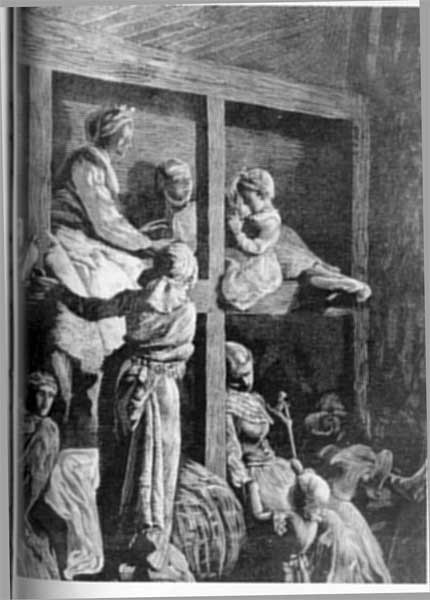
Scenes from a "coffin ship".
Some idea of the conditions endured by people on the coffin ships of the famine period can be gleaned from the story of the "Elizabeth and Sarah", which sailed from Co. Mayo in July 1847. She carried 276 persons, instead of the 212 listed, and had only 8,700 gallons of water for the voyage, instead of the 12,532 gallons she should have had. Each passenger was entitled to be given 7 lbs of provisions each week, but none was ever distributed. The 276 passengers shared 32 berths, and there was no sanitary facility of any kind. The voyage took eight weeks, because the captain took the wrong course, and by the time the ship broke down and was towed into the St. Lawrence River in September, 42 people had died.
Approximately 98% of passengers travelled as steerage with 2% travelling cabin class. Cargo was loaded first, then the cabin passengers and only when the ship was ready to sail could steerage passenger’s board. Most of the passengers had never been on a ship before. Leaving was an emotional moment as they caught their last glance of home.
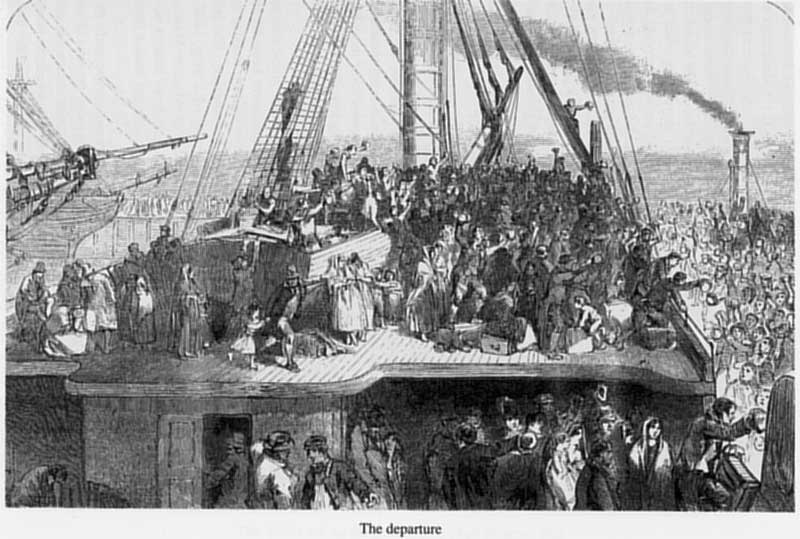
Departure Scenes
Steerage passengers had to cook and fend for themselves, crammed together on the lower decks. Overcrowding was a constant problem leading to outbreaks of cholera and typhus. David Hollet observed that “British emigrant ships on the north Atlantic run only allowed ten feet of space for every adult, two children counting as one, and infants not being include in the calculations. American ships, being somewhat better, allowed for fourteen feet for every steerage passenger. In relation to food, it was only incumbent on ship owners to provide steerage passenger with water and biscuits the quality of which was often questionable. Steerage passenger were expected to bring their own food on board and cook it as required on the few grates provided. Cooking took place on the open deck leaving passengers open to bad weather and the danger of fire. The staple food of Irish emigrants on the ships was oatmeal and water, boiled into what was called mush, or burgoo by the sailors. Pigs were often killed and cooked on deck. Often fires could not be lit for long periods due to weather conditions and passengers were compelled to eat raw food.
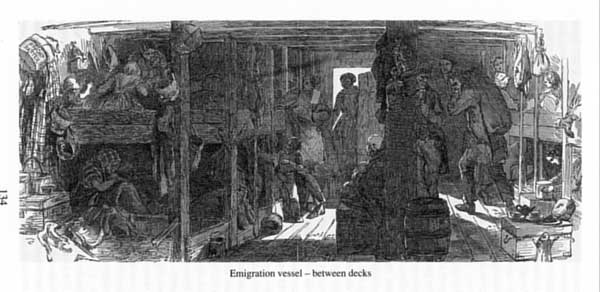
Between decks on an emigrant vessel.
Health care on these ships was either totally inadequate or non-existent. Most ships had no proper toilet facilities and even when rudimentary water closets were provided, these were located on the open deck, and could not be used in rough weather. Disasters and shipwrecks also took their toll.
Passengers tried to make of their lot. There was often music among steerage passengers as someone invariably had a flute or a fiddle or even a set of bagpipes. A dance might take place on deck in the evening if captain did not stop it. The sighting of strange fish and unusual creatures was also common distraction.

Whiling away the journey by dancing between the decks.
Until 1850, when iron-hulled screw steamers were introduced, it took at least a month to cross the Atlantic. By the 1870s the journey held fewer terrors as steamships cut the travelling time, competition reduced fares and government regulation greatly improved conditions on board ship. Fares fell to as little as £1.16d and the Cunard line had reduced travel time to two weeks by the late 1850s.
Remittances
The Irish Emigrant Society expanded its activities to found the Emigrant Industrial Savings Bank in 1850. This greatly helped the Irish to send home remittances thus leading to “chain emigration”. Between 1845 and 1854 when the famine was at its worst, $19 million dollars was sent back to Ireland much of it in the form of prepaid tickets so that families could be reunited. Thus chain migration began as inhabitants of Ireland followed their brothers, sisters, parents, aunts and uncles to the US. Historian Arnold Schrier has calculated that the Irish in America sent over $260 million back to Ireland during the latter part of the nineteenth century. Dennis Clarke called this phenomenon “the greatest transatlantic philanthropy of the nineteenth century”. In 1864 one writer confidently asserted that not more than 5% of the emigrants from Mayo paid their own passage (Mayo Constitution, March 15th 1864). Remittances were used to pay rent and shop bills. As late as the turn of the century a visitor to Achill Island observed that the island supported a population far larger than could be supported by the meagre farming and spasmodic fishing in the area. This was due to American money sent home by absent sons and daughters. (R.L Praeger, The Way that I went)
This is a typical letter written in a clear educated hand by a dutiful daughter to her parents in Cork in 1850:
My Dear father and mother,
I remit to you in this letter, 20 dollars, that is four pounds, thinking it might be some acquisition to you until you might be clearing away from that place altogether and the sooner the better, for believe me I could not express how great would by my a joy at our seeing you all here together where you would never want to be at a loss for a good breakfast and dinner.
Your ever dear and loving child,
Margaret McCarthy (TPC 285)
The Weekly Freeman which circulated among Irish communities abroad carried advertisements from families in Ireland seeking emigrants who had left many years before and disappeared. Many advertisers appear to have been ageing parents anxious for news of their emigrant sons and daughters. For example:
Hayes, Charles; left Ballynew, Castlebar in 180?, last heard of 15 years ago, he was then in Chicago.. Sought for by his mother
Sometimes newspapers carried advertisements from those who had emigrated, or their children, endeavouring to trace their families who had stayed in Ireland. The Weekly Freeman claimed to have made 75 discoveries in 1899, but this figure represents only a very tiny percentage of the numbers of people being sought. Many thousands must have lost contact never to be found.
Of course newspaper advertisements were also used to try to separate emigrants from their money. The New York Herald of June 1, 1848, ran this ad:
Emigrants! - The Miseries and troubles of sickness from change of climate can, in a great degree, be saved you if you procure and keep by you the Brandeth Pills to be immediately resorted to should your health become affected. Days, months, nay years of sickness may be thus prevented

